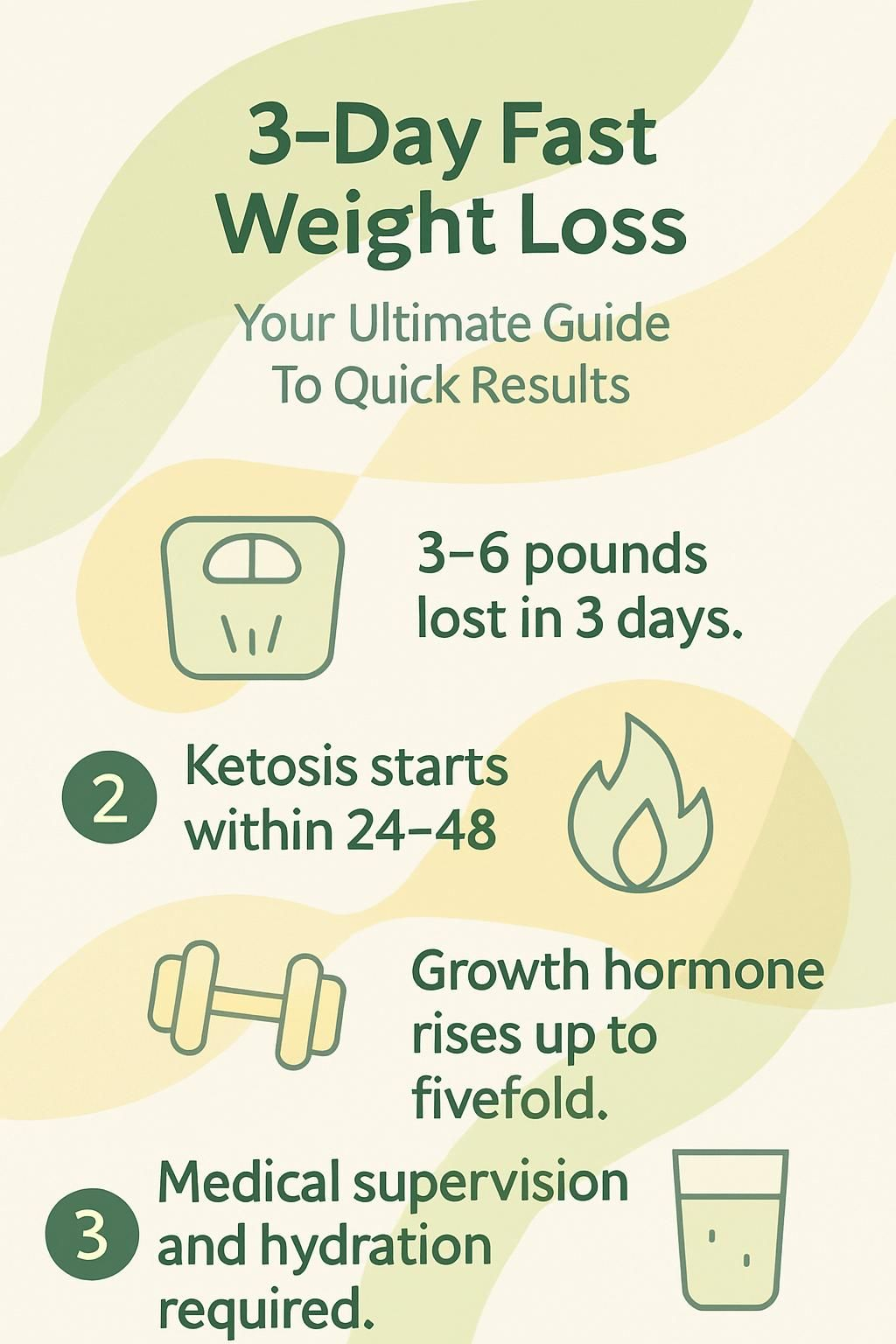3-Day Fast Weight Loss: Your Ultimate Guide To Quick Results
Our Nutrition Assistant AI Suite will transform your body. You will lose fat, get toned, and build muscle. Gain confidence and optimal health.
Trying to lose weight fast can feel discouraging when typical dieting stalls. A structured 3-day fast, often called a water fast, limits intake to plain water for 72 hours and can prompt quick changes in fat use and cell cleanup.
This guide shows how fasting for three days works, the benefits and risks, and how to prepare and refeed safely. Use it to decide if this short reset fits your goals and your health profile.
Keep reading to learn the facts and get a safe plan for a 3-day water fast.
Key Takeaways
- A 3-day water fast often leads to 3 to 6 pounds lost. About 70 to 80 percent is water weight. Fat loss is usually 0.5 to 1.5 pounds over 72 hours (clinical trials, 2024).
- Ketosis, the state where you burn fat for fuel, begins around 24 to 48 hours. Autophagy, the cell cleanup process, peaks near Day 3 and may lower inflammation (Queen Mary University, 2024).
- Insulin drops during fasting while growth hormone can rise up to fivefold by Day 2. This shift helps protect muscle while using stored fat for energy (Nature Metabolism, 2024).
- Main risks include electrolyte imbalance, dehydration, dizziness, and heart rhythm issues. Fasting is unsafe during pregnancy, for those under 18 or over 65, and for people with certain medical conditions.
- Make fasting safe with medical supervision, steady hydration, electrolyte monitoring, slow refeeding with broth and soft foods, and stop if you have severe dizziness or an irregular heartbeat.

Understanding a 3-Day Fast

A 3-day fast means you consume only plain water for seventy-two hours. People often compare it with intermittent fasting since both affect calorie intake, metabolism, and insulin sensitivity in different ways.
What is a 3-day fast?
During a 3-day fast you drink only water for a full 72 hours. No food, no calorie drinks, and no supplements unless your clinician advises them. This is water-only fasting, which is more intense than daily time-restricted eating.
After 12 to 24 hours your body uses stored glycogen, which is the way your muscles and liver store carbohydrate. By Day 2 you enter ketosis, a state where fat becomes your main fuel.
Rapid weight loss is common. Most see 2 to 6 pounds down, largely from water released with glycogen. True fat loss tends to be modest, about 0.5 to 1.5 pounds, and any lean mass drop early is mostly water, not muscle protein.
How is a 3-day fast different from intermittent fasting?
A 3-day fast is a continuous 72-hour window with only water. Intermittent fasting limits your eating window each day, such as the 16:8 plan, or uses patterns like OMAD or 20:4.
Short daily fasts are easier for most people and fit normal schedules. A 3-day fast drives deeper changes. Glycogen falls quickly, ketones rise on Day 2, and cell repair processes like autophagy become more active by Day 3.
Potential upsides of a 3-day water fast include stronger fat burning, improved insulin sensitivity, and deeper cellular cleanup. It is harder to do and should not be attempted without medical supervision if you have health conditions such as type 1 diabetes.
How a 3-Day Fast Works
Fasting shifts your body from sugar to fat as fuel. It also signals cleanup inside cells, which may support health beyond weight loss.
How does glycogen depletion affect energy during fasting?
Muscles and liver store about 500 grams of glycogen. Each gram binds roughly 3 grams of water. During the first day of fasting, glycogen breaks down to keep blood sugar level steady.
As glycogen drops, water is released. Many people see 4 to 7 pounds of water weight fall off early. Insulin declines while growth hormone rises, and you may feel low energy until your body adjusts.
Some feel lighter but also weaker during this phase. A short walk and steady hydration can help while your fuel source changes.
What happens when the body transitions to ketosis and burns fat?
After about 24 to 48 hours, glycogen stores run low. Your liver produces ketone bodies, which fuel the brain and other organs. Growth hormone can rise up to fivefold by Day 2, which helps defend muscle while fat is used for energy.
Metabolic rate may dip slightly by Day 3, often 3 to 8 percent. Many report clearer thinking once ketosis stabilizes. Across three days, the calorie deficit often totals 5,000 to 7,500 calories, which aligns with 0.5 to 1.5 pounds of fat lost for many people.
On the second day of fasting, I felt my energy shift—my mind felt sharper as my body burned fat instead of sugar.
How does fasting trigger cellular repair and autophagy?
Lower insulin and mild cellular stress activate autophagy, which is a cell cleanup and recycle system. Damaged proteins and worn parts get broken down and reused.
Research from Queen Mary University in 2024 points to high autophagy activity by Day 3. Cells clear faulty proteins and weak mitochondria, which may lower inflammation and support long-term health.
Many people notice steadier energy and clearer skin by the end of Day 3. These changes reach past quick weight loss and may support tissues under daily stress.
What Weight Loss Can You Expect from a 3-Day Fast?
Expect a noticeable drop on the scale. Most of it is water weight, with a smaller portion from fat loss.
How much weight do people typically lose during a 3-day fast?
Typical loss ranges from 3 to 6 pounds in three days. About 70 to 80 percent is water and glycogen. The rest, often 0.5 to 1.5 pounds, is fat.
Starting size matters. Smaller bodies usually lose fewer total pounds. Larger bodies tend to lose more total pounds, but the same pattern holds, most of it is water early, with a modest amount of fat.
Fast results on the scale can help motivation. For lasting change, the plan after the fast matters more than the number you see on Day 4.
What factors influence weight loss results during fasting?
Results depend on your starting body fat, recent diet, and activity. High-carb and high-salt eating before a fast can lead to more water loss early because glycogen holds water.
Light activity can support fat use. Intense workouts raise the risk of low blood sugar or dehydration while fasting. Health conditions, such as insulin resistance or type 2 diabetes, can change how quickly you shift into ketosis and how your blood sugar behaves.
Short-term success is helpful, but keeping balanced meals after the fast is what locks in progress.
What Does Science Say About Fasting?
Human studies show that fasting changes hormones and energy use across the body. These shifts can persist after you start eating again.
How does the body adapt during a fast?
Early on, your body burns glycogen. After about a day without food, fat use increases as ketosis builds. This switch helps protect important tissues and lets you function on a different fuel.
A 2024 Nature Metabolism paper reported thousands of protein changes across organs after a three-day fast. Those shifts support stress control and metabolism. Volunteers maintained some benefits after refeeding under clinical guidance.
Many people notice less hunger by Day 2. That is a sign your body is using fat and ketones more efficiently.
What role do calorie deficit and fat oxidation play in fasting?
Fasting creates a large calorie deficit, often 5,000 to 7,500 calories in three days. After glycogen drops, fat oxidation takes the lead. Your cells break down stored fat to cover the gap.
Managed well, this can equal 0.5 to 1.5 pounds of fat loss in 72 hours. Poor planning may leave you dehydrated or lightheaded, so hydration and electrolytes are key for safety and performance.
Key Benefits of a 3-Day Fast
Many people start for weight loss, then notice changes in blood markers, energy, and mental focus.
Rapid fat loss and body composition improvements
Many see 4 to 6 percent of body weight drop within three days, most of it as water and glycogen. Fat loss is modest in that window, yet the waist can look leaner due to fluid shifts. Muscle protein is generally protected during short fasts.
As ketosis builds, fat oxidation rises and clothes may fit looser by Day 3. For precise tracking, consider a DEXA scan one to two weeks after your fast to separate water changes from true fat loss.
Enhanced autophagy and cellular repair
Day 3 aligns with peak autophagy in many people. Cells recycle damaged parts and reduce waste proteins, which may lower inflammation and strengthen stress defenses.
These cleanup effects are a major reason some people fast. They support long-term health, not just short-term body changes.
Improved metabolic health
Fasting can lower fasting glucose by 5 to 10 mg/dL and reduce markers like C-reactive protein. Blood pressure may improve and insulin sensitivity often rises, all of which support cardiovascular health.
Better hunger cues are common. People report fewer cravings and more stable energy once the first day passes. Hormones tied to appetite, such as leptin and adiponectin, often trend in a favorable direction.
Increased mental clarity and focus
On Days 2 and 3, many notice steadier focus as ketones fuel the brain. Less blood sugar fluctuation can mean less brain fog and a calmer mood.
Some also sleep better by the second night. This clear-headed stretch can help you plan your post-fast meals with more care.
Risks and Safety Measures for a 3-Day Fast
A 3-day fast stresses fluid and mineral balance. Speak with a healthcare professional first, especially if you take medicines or have chronic conditions. This article is educational and not medical advice.
What are potential side effects of fasting?
Dizziness, fatigue, and headaches are common as you adapt. Electrolyte problems, such as low sodium, potassium, or magnesium, may cause cramps or irregular heartbeat. Dehydration can lead to low blood pressure when you stand up.
Skipping a careful refeed raises the chance of refeeding syndrome, which is rare but dangerous and needs urgent care. Headaches and mild cramps often improve with hydration and medical guidance on electrolytes.
Who should avoid fasting?
Avoid fasting if you are pregnant or breastfeeding. Those under 18 or over 65 should only fast with medical supervision. People with a history of eating disorders should not fast.
Do not attempt a water-only fast if you have type 1 diabetes, advanced kidney disease, serious heart conditions, or a very low BMI. If you take prescription drugs, ask your clinician before any fasting plan. Some medicines require food.
Know the warning signs so you can stop quickly if needed.
What warning signs mean you should stop fasting immediately?
Stop at once if you have severe dizziness, fainting, chest pain, or an irregular heartbeat. Confusion, ongoing vomiting, or intense weakness may point to electrolyte imbalance.
These symptoms can harm your health if ignored. Seek medical care promptly.
How to Prepare for a 3-Day Fast
Set yourself up for success. Small changes in the days before the fast make the experience smoother and safer.
What dietary changes should you make before fasting?
Begin prep three days out. Reduce caffeine to avoid withdrawal headaches. Cut added sugars and ultra-processed foods to limit swings in blood sugar.
Eat plenty of vegetables, berries, and nutrient-dense meals to top up vitamins and minerals. Hydrate well. The night before, have a moderate dinner with protein and healthy fats. Skip alcohol and aim for 7 to 9 hours of sleep.
Prepare broth and any clinician-approved electrolyte products in advance so you are not scrambling once the fast starts.
Why is hydration and electrolyte balance important?
Drink 2 to 4 liters of water per day during the fast unless your clinician advises otherwise. Water and electrolytes keep blood pressure stable and help nerves and muscles work correctly.
Shortfalls in sodium, potassium, or magnesium can cause headaches, cramps, or in rare cases serious complications. Work with your healthcare provider on whether electrolyte supplements are right for you during fasting.
What supplies might you need for a fast?
Gather filtered water, a simple electrolyte product if approved, and urine ketone strips if you want feedback on ketosis. A home blood pressure monitor can help you track safety.
Prepare low-sodium bone broth for refeeding and stock soft, easy-to-digest foods like cooked vegetables, berries, and eggs for the first meals after the fast.
Daily Breakdown of a 3-Day Fast
Each day brings a different shift. Think of it as a short journey from sugar to fat, then into repair mode.
What happens on Day 1: glycogen depletion and managing hunger?
Day 1 is the hardest for many. Hunger peaks around hours 16 to 20. You may feel moody or notice a headache as glycogen falls.
The scale often drops 1 to 3 pounds, mostly water released with glycogen. Drink water often. Try light walks, not hard workouts. Reduce food cues, like scrolling food videos, and go to bed early to limit cravings.
Day 2 usually brings steadier energy as you move toward fat burning.
What occurs on Day 2: entering ketosis and fat burning?
With glycogen low, your body ramps up ketone production. Hunger often fades and mental clarity rises. You might notice a fruity scent on the breath due to acetone, a type of ketone.
Growth hormone remains elevated, which helps protect lean mass. Gentle movement, stretching, or journaling can support this stage without overtaxing your system.
What peak benefits happen on Day 3: cellular renewal?
Day 3 often aligns with peak autophagy. Cells recycle damaged parts and clear waste, which supports healthier tissues.
Ketones provide steady brain fuel, and many people feel calm, focused, and in control. Plan your refeed carefully since your digestive system is sensitive after several days without food.
How to Refeed Safely After a 3-Day Fast
Your system needs a soft landing. A gentle refeed protects your heart, nerves, and gut while locking in your results.
How to gently reintroduce food in the first 6 hours?
Begin with 1 cup of low-sodium bone broth. It provides hydration, electrolytes, and amino acids with low strain on digestion. Wait 1 to 2 hours before the next food.
Then try one half cup of steamed vegetables like zucchini or carrots, or soft foods such as berries or avocado. Eat small portions every 2 to 3 hours. Avoid heavy, high-fat meals, sugary snacks, very high fiber, and large raw salads on the first evening.
What are safe refeeding strategies during the first 3 days post-fast?
Start with 300 to 400 calories for the first meal. Choose broth, eggs, or well-cooked vegetables. On Day 2 after the fast, raise intake to about 1,000 to 1,200 calories across two meals. Add lean protein such as chicken or fish and easy carbs like rice or potatoes.
By Day 3 post-fast, move toward your normal calories or a slight deficit if weight loss remains the goal. Keep protein near 1.2 to 1.6 grams per kilogram of body weight. A Mediterranean-style pattern with fruits, vegetables, whole grains, and olive oil supports metabolic health.
If you feel weakness, swelling, or confusion, seek medical care. These can be signs of refeeding syndrome.
Alternative Fasting Methods
If a full 72-hour fast feels too intense, shorter or modified plans can still provide benefits with a lower risk profile.
What are modified fasting options?
Fasting-mimicking diets provide very low calories for about five days, under medical oversight. They imitate many fasting signals while still offering small amounts of food.
Shorter options include 16:8 or 20:4 time-restricted eating, alternate day fasting with limited calories every other day, and the 36-hour fast where you skip one full day. These methods can deliver solid results with fewer side effects for most people.
How does a 3-day fast compare with intermittent fasting?
A 3-day fast stops calories for 72 hours, often deepening autophagy and creating a stronger metabolic reset. Intermittent fasting sets a daily or weekly schedule for eating windows, which most people can sustain long term.
Extended fasting may give faster early changes on the scale due to water shifts and initial fat use. Intermittent fasting builds results over weeks, with a safety profile that works better for many lifestyles.
Frequently Asked Questions
Use these quick answers to plan your approach and avoid common mistakes.
Can I exercise during a 3-day fast?
Strenuous exercise is not advised. Glycogen is low after the first day, which limits quick energy and raises the risk of dizziness. Light walking, gentle stretching, or easy yoga is usually fine.
Moderate movement helps circulation without pushing your system too hard. Save high-intensity training for after you refeed.
Will I lose muscle while fasting?
Significant muscle loss is unlikely during a short 3-day fast for healthy adults. Research suggests most early lean mass changes reflect water and glycogen, not muscle protein.
Growth hormone rises during fasting, which helps protect muscle. Adequate hydration and rest further reduce risk.
How often is it safe to do a 3-day fast?
There is no single guideline for frequency. Repeating extended fasts too often can strain organs and deplete nutrients. Consider building experience with 24 to 48-hour fasts first, and involve your clinician for labs and follow up.
For most people, time-restricted eating or a 5:2 style plan offers safer long-term weight management with fewer side effects.
Conclusion
A 3-day fast can deplete glycogen, trigger ketosis, and increase autophagy. Many people see quick weight loss between 2 and 6 pounds, mostly from water early, with modest fat loss. Some also notice steadier energy, better hunger control, and sharper focus.
Work with a healthcare provider before attempting more than a day of fasting, especially if you take medicines or have medical conditions. With sound prep, a careful refeed, and a plan for the week after, a short water fast can be a safe, focused tool on your path to healthy weight and better metabolic health.
FAQs
1. How much weight can a person expect to lose in a 3-day fast weight loss plan?
Most people see a loss of about 2 to 5 pounds over three days. This change is often due to water leaving the body and not just fat reduction. Research shows that rapid weight changes in short periods are usually not from fat cells shrinking but from shifts in body fluids.
2. Are there risks for organs or cells during quick weight loss?
Rapid weight loss can stress organs such as the liver and kidneys, which work hard to process changes in metabolism. Cells may also lack key nutrients if intake drops too low, which can affect how well organs function.
3. What foods are best for supporting health during a short-term fast weight loss plan?
Berries are rich in vitamins and antioxidants, making them good choices for cell health during calorie restriction. Eating foods high in fiber and nutrients helps protect organs while supporting safe weight changes.
4. Do studies show better results with short-term or long-term weight loss plans?
Studies comparing quick plans like the 3-day fast with longer approaches find that while days showed better initial results, long-term changes are more likely to keep pounds off. Loss typically returns if healthy habits do not continue after the short period.
Summary: A 3-day fast can lead to rapid but mostly temporary weight changes by affecting body fluids rather than fat cells alone. Organs and cells need careful support during this time; berries and nutrient-rich foods help maintain their function. Evidence suggests lasting success comes from ongoing healthy habits rather than only short bursts of restriction.







